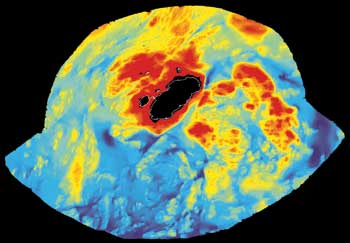Monhegan Study
by Mike Crowe
|
A study done at Monhegan, with a goal of better understanding the relationship between trap density and the associated lobster mortality, has released its findings. The project was funded by a grant from the Northeast Consortium, a federally funded agency that facilitates co-operative research. Carl Wilson, chief lobster biologist at the Maine Department of Marine Resources, was the lead scientist for the project. Monhegan fishermen participated, setting and hauling traps and recording the results.
The study has yielded a range of information and is expected to produce more in the future. Right now, said Carl Wilson, “one of the most interesting results was the trap density with the highest yield.” Trap densities between 50 per square kilometer (1 square kilometer = .386 square miles) and 1,000 per square kilometer were studied. The highest yielding density was 150 per square kilometer. “Traps set at 150 per square kilometer caught within 10 percent of what the traps set at 500 per square kilometer caught,” he said.
Aside from the obvious political and economic speculation that could be made from this one aspect, Wilson says this study was an important, necessary and potentially profitable experiment for the fishermen. But added, “It is a first step, not the final word. This study is two months, on one island, in one year.” Wilson said earlier, “Clearly, there’s a lot we don’t know about how these creatures operate (lobsters and lobstermen). But, with so much at stake I’m afraid if we don’t begin to get a handle on some of these questions we may find ourselves in a position we do not want to be in.”
|

Bathymetric map of Monhegan area. A 35' lobster boat with multi-beam sonar equipment on board captured detailed imagery of the Monhegan conservation zone’s approximately 30 square mile bottom. The map shows a mosaic of water depths and bottom types. Red is a depth of 6' and blue is about 450’. It will be used as a base line for future research. Photo: DMR |
|
|
|
|
Bernard Raynes — Fisherman
by Mike Crowe
|
Fishermen are the last of the world’s hunters. Hunters who dragged the parts of a mastodon into the village didn’t get a new pick-up, but on the other hand, they probably didn’t have to clean up after the feed either. According to either the conservative estimate for human life on earth at 20,000 years, or the scientific estimate at about 3-4 million years, humans, like other animals, have been hunting for a long time. A few decades in front of the television isn’t likely to have completely erased the impact of this past.
A few thousand years ago, Maine-coast Native Americans hunted swordfish from rocks when they swam inshore. Today, among the last of the swordfish hunters in the Gulf of Maine is Bernard Raynes of Owls Head. Bernard is a lifelong fisherman—a veteran of many fisheries—from a family of fishermen that goes back to the earliest days of European settlement on the Gulf of Maine coast. Raynes lives fishing like a fish lives in water; it’s in his blood, his heart and his mind.
Raynes’ approach to fishing, as well as to life, were shaped by many generations of fishermen on both sides of his family—his experiences with them directly, and the tales of those he never met. The ways of the grandparents and parents, early days spent in boats and around water in the once-common fish houses of islands and coast, described how things were and must be for Raynes.
Raynes is the eleventh generation of Rayneses in North America. After his ancestor Francis Raynes arrived in Falmouth, Maine in 1646, his ancestors have lived and fished in the Gulf of Maine ever since. His mother’s family, the LeBlancs, are among the original settlers who came to Acadia in 1646. The English and French contested that early settlement’s boundary, and they eventually found their way to Nova Scotia before coming to Maine. Ironically, that border dispute would surface again to impact the Rayneses.
Fishing in the Gulf of Maine has evolved over the decades and centuries. For the small operators, things changed less, leaving aspects of the hunt in their occupation. For some fishermen, the hunt was a prominent part of their fishing until very recent years. A few of these were the sword fishermen who hunted with harpoons.
continue
|
| A swordfish being brought aboard the Irene and Alton, 1980’s. Bernard Raynes works the hauler at left as author/fisherman Paul Molyneaux moves from view. Raynes’ said recently that this was his favorite fishery. They steamed out to Georges, the edge of the Gulf stream and the northeast peak hunting sword and occasionally getting the big one. Photo: Bernard Raynes |
|
|
|
|
|
  
|
|

